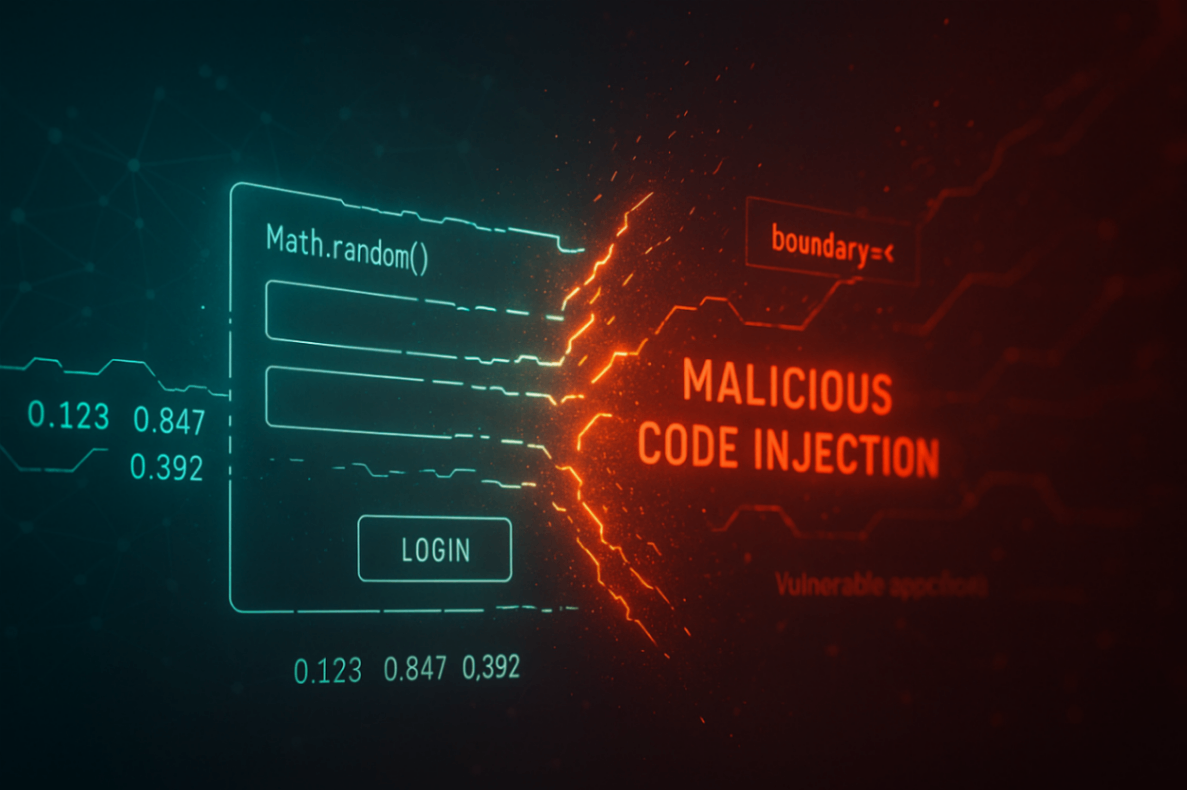Critical form-data Vulnerability CVE-2025-7783: How Predictable Random Numbers Enable Parameter Injection Attacks

The JavaScript ecosystem faces another significant security challenge with the discovery of CVE-2025-7783, a critical vulnerability in the widely-used form-data library. This vulnerability demonstrates how seemingly innocuous coding practices can create serious security holes that attackers can exploit to inject malicious parameters into multipart form requests.
What is the Vulnerability?
The vulnerability lies in how the form-data library generates boundary values for multipart form-encoded data. Instead of using a cryptographically secure random number generator, the library relies on JavaScript's Math.random() function, which produces pseudo-random values that are predictable once an attacker can observe the pattern.
The Root Cause
The problematic code can be found in the form-data library where Math.random() is used to generate boundary strings that separate different parts of multipart form data. Since Math.random() uses a linear congruential generator (LCG) algorithm, its output follows a predictable pattern that can be reverse-engineered.
When an attacker can observe several sequential Math.random() values from an application, they can:
Determine the current state of the pseudo-random number generator (PRNG)
Predict future values, including those used for form boundary generation
Craft malicious payloads that contain the predicted boundary value
Inject additional parameters into requests that weren't intended to be user-controlled
How the Attack Works
The attack scenario requires two key conditions:
Observable Math.random() Values: The attacker must be able to observe other values produced by
Math.random()in the target application. Common sources include:Request ID headers (like
x-request-id)Session tokens
CSRF tokens
Any client-side generated identifiers
User-Controlled Input: The attacker must be able to control at least one field in a request that uses the vulnerable
form-datalibrary.
Once these conditions are met, the attacker can:
Monitor the application's
Math.random()outputs through various side channelsCalculate the PRNG state using the observed values
Predict the next boundary value that will be used by
form-dataCraft a payload that includes this boundary, effectively "breaking out" of their controlled field
Inject additional form parameters that the application didn't intend to accept
Real-World Impact
This vulnerability is particularly dangerous because:
Parameter Injection
Attackers can inject arbitrary parameters into requests sent to internal systems, potentially:
Bypassing authentication checks
Modifying sensitive configuration values
Accessing restricted functionality
Escalating privileges
Internal System Compromise
Since many applications use form-data to communicate with internal APIs or services, successful exploitation could lead to:
Unauthorized access to backend systems
Data manipulation or theft
Service disruption
Lateral movement within the network
Scale of Exposure
The form-data library is extremely popular in the Node.js ecosystem, used by countless applications for handling file uploads and API communications. This means the potential impact extends across a vast number of applications and services.
Who Is at Risk?
Applications are vulnerable if they meet both of these criteria:
Use form-data with user input: The application uses the
form-datalibrary to send requests containing user-controlled data to other systemsExpose Math.random() values: The application reveals
Math.random()outputs through headers, responses, or other observable channels
Common vulnerable scenarios include:
File upload services that proxy uploads to cloud storage
Webhook systems that forward user data to external APIs
Microservices architectures using form-data for inter-service communication
Applications with request tracing that use Math.random() for correlation IDs
Mitigation Strategies
Immediate Actions
Update Dependencies: Check if your version of
form-datais affected and update to a patched version as soon as one becomes availableAudit Math.random() Usage: Review your codebase for places where
Math.random()values might be exposed to users:HTTP headers
API responses
Client-side code
Log files accessible to users
Input Validation: Implement strict validation on user inputs that are processed by
form-datato prevent boundary injection attempts
Long-term Solutions
Use Cryptographically Secure Random Sources: Replace
Math.random()with cryptographically secure alternatives:Node.js:
crypto.randomBytes()orcrypto.randomUUID()Browser:
crypto.getRandomValues()
Implement Defense in Depth:
Sanitize and validate all user inputs
Use allowlists for acceptable parameter names
Implement request signing or authentication for internal API calls
Security Headers: Avoid exposing random values in HTTP headers when possible, or use secure random sources for any exposed values
Detection and Monitoring
To detect potential exploitation attempts:
Monitor for suspicious form data: Look for requests with unusual boundary patterns or unexpected parameter combinations
Log analysis: Watch for requests that contain form boundaries in user-controlled fields
Anomaly detection: Implement monitoring for unusual parameter patterns in requests to internal APIs
The Broader Lesson
This vulnerability highlights several important security principles:
Cryptographic Randomness Matters
The use of Math.random() for security-sensitive operations is a common antipattern. Developers should always use cryptographically secure random number generators when randomness has security implications.
Side Channel Attacks
Even seemingly harmless information leakage (like request IDs) can become powerful attack vectors when combined with other vulnerabilities. This emphasizes the importance of considering the broader security implications of any data exposure.
Supply Chain Security
Popular libraries like form-data are used by millions of applications. A single vulnerability can have massive downstream effects, highlighting the critical importance of secure coding practices in open-source dependencies.
Conclusion
CVE-2025-7783 serves as a stark reminder that security vulnerabilities can lurk in the most unexpected places. What appears to be a simple random number generation issue can become a critical security flaw when combined with the right conditions.
Development teams should:
Immediately assess their exposure to this vulnerability
Review their use of
Math.random()throughout their applicationsImplement proper input validation and sanitization
Consider the security implications of any data they expose to users
As the JavaScript ecosystem continues to evolve, incidents like this underscore the importance of security-first development practices and the need for ongoing vigilance in managing our software supply chains.
The security community's quick response to identifying and documenting this vulnerability demonstrates the value of collaborative security research. By sharing knowledge and maintaining transparency about security issues, we can work together to build a more secure web for everyone.
Related Topics:
Did you enjoy this article?
Enjoying our content?
Subscribe to our newsletter to get the latest updates and insights.
Subscribe Now